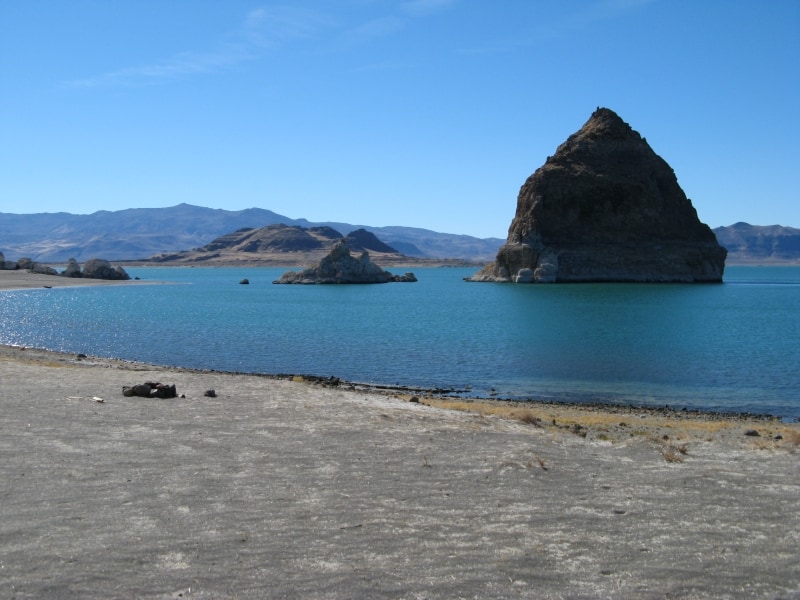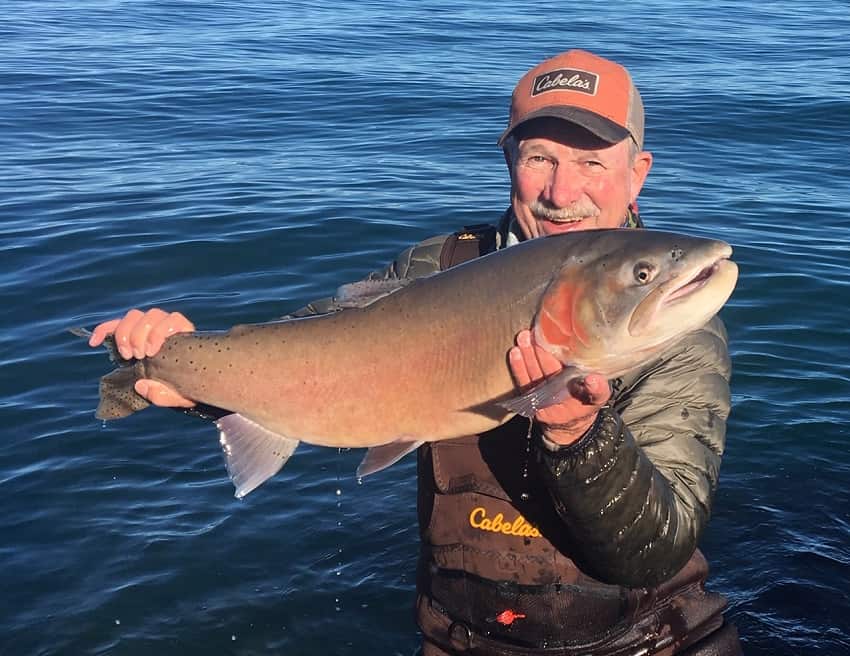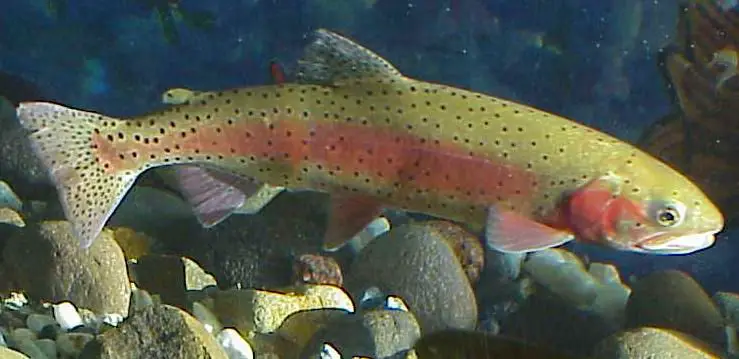Characteristics
Lahontan’s are silvery grey to green backed with yellowish-brown sides and a red or pink belly. They have round black spots scattered over their sides, being more densely concentrated towards the tail. Lahontan Cutthroat Trout also sport the red or orange slash marks behind the jaw on the throat that all Cutthroat species have.
Lahontan Cutthroat Trout is the largest inland trout species. The lake version of these fish grows close to 4 feet long and weighs up to 40 pounds. Although the official world record is 41 pounds, there are some accounts from early settlers of sixty pounds plus Lahontan Cutthroat Trout.
In mountain streams, 10 to 12 inches is on the upper end of these fish’s size range.
Historical Range
The Lahontan Cutthroat Trout is native to the Lahontan Basin of northern Nevada, northeastern California, and southeastern Oregon.
The Lahontan Basin encompasses the area that was once submerged beneath the former giant Ice Age, “Lake Lahontan.” Lake Lahontan once covered over 8610 square miles and had a maximum depth of over 500 feet. The majority of Lake Lahontan no longer exists, though. Pyramid and Walker Lakes in Nevada are the remaining remnants of this ancient body of water.
Both Pyramid and Walker lakes lie in the Great Basin. The Great Basin stretches from the eastern slopes of the Sierras in the west to the western slopes of the Wasatch range in the east. North to south, it stretches from southern Oregon to Death Valley, California.
No waters in the Great Basin flow to the ocean. Instead, they flow to low points within the basin. Both Pyramid and Walker Lakes are endorheic, meaning they have no outlet. The only way for water to exit them is through evaporation. Since these lakes have no outlets, salts and other minerals tend to concentrate on them, especially when there are insufficient inflows.

History of the Pyramid and Walker Lake Lahontan Cutthroat Trout
The recent history of the Lahontan Cutthroat Trout is entwined with the discovery, conquest, and settlement of the western United States. If you become bored with inane historical facts, bear with me anyway. The history is important. It tells the tale and explains why one strain of these fish was almost completely lost and where they are at today.
Lahontan Cutthroat Trout In Walker Lake
Walker Lake is a remnant of ancient Lake Lahontan. It is a terminal desert lake meaning it has no outlet. The only way water leaves it is through evaporation. Salinity levels in Desert terminal lakes are susceptible to fluctuations in freshwater inflows.
Walker Lake sits in a trough that extends from southern Oregon to Death Valley, California, called Walker Lane. Walker Lane is the namesake of Joseph Walker, who explored the area with John C Fremont in the 1840s.
Lahontan Cutthroat Trout Fishery
Lahontan Cutthroat Trout once thrived in Walker Lake, reaching sizes over thirty pounds.
When the first explorers discovered the Lake in the 1840s, the Walker River Paiute people were already there. They referred to themselves as the Agai-Dicutta Numa, which means “trout eaters.” They depended on the giant Lahontan Cutthroat Trout from the lake and Walker river for a major portion of their subsistence lifestyle. At this time, the lake’s elevation was 4,080 ft. above sea level. The level of the Lake is now over 150 ft. lower than it was then. I’ll talk more about that later.
In the late 1800s, settlers formed communities in the Walker River Valley. They then diverted water from the river to irrigate their crops.
Diverting Water For Irrigation
Sometime in the 1920s, the Walker River Irrigation District was formed, and both the East and West forks of the Walker River had dams constructed on them to hold back spring runoff to be used for irrigation in the drier portion of each year. Also, in 1935 the Bureau of Indian Affairs constructed a reservoir on the lower Walker River to capture spring runoff to supply irrigation water to the Walker River Paiute Tribe reservation
The Diversion of irrigation water from the Walker River helps sustain life and has created a thriving agricultural economy along its course. No one can coherently argue to the contrary. As with any progress to humankind, though, there are always unintended consequences.
Due to a large portion of the Walker River being diverted for irrigation use, at times, there was no inflow to Walker Lake. This, along with the impediment that dams create as permanent barriers, made spawning runs of Lahontan Cutthroat Trout impossible from the early 1900s on.
In the 1950s, the Nevada Department of Fish and Wildlife reestablished the Lahontan Cutthroat Trout Fishery in Walker Lake through stocking to success. The big trout were once again plentiful in the Lake’s waters, but more trouble was looming on the horizon.
Rising Salinity of Walker Lake
As evaporation from the lake has exceeded inflows year after year, the “TDS” or Total Dissolved Solids in the lake water has increased proportionately. While freshwater has TDS of less than 1,000 Milligrams per liter, The Water in Walker Lake now has TDS of over 21,000 Milligrams per liter. At these levels, the native flora and fauna of the lake can no longer survive.
The Nevada Department of Fish and Wildlife no longer stocks fish in Walker Lake. The water is much too alkaline to support any of the native species that once lived there. The Tui Chub is the last fish species still living in the lake, and they are only holding on by a thread. The last documented Lahontan Cutthroat Trout from Walker Lake was in 2009.
Enter a nonprofit organization called Walker Basin Conservancy. The mission statement from their website says the following.
“Walker Basin Conservancy is leading the effort to restore and maintain Walker Lake while protecting agricultural, environmental and recreational interests throughout the Walker Basin.“
The Walker Basin Conservancy’s stated goal is to restore inflows to Walker Lake from the Walker River sufficiently to reduce TDS in Walker Lake from 21,000 down to 12,000 mg per liter. This is the level that the native aquatic life can tolerate and exist within the lake. They propose to accomplish this by buying and leasing agricultural water rights along the Walker River and putting the water back in the river to go into the lake. They estimate that they have acquired 49.8% of the water necessary to accomplish this at present.
Here’s their web address for anyone interested in learning more about the Walker Lake Conservancy.
Their cause is a noble one. I also appreciate the way they are going about it, not like fanatics or zealots. They are striving to solve a problem to the benefit of all.

Pyramid Lake Lahontan Cutthroat Trout Recent History
In 1844 Lieutenant John Fremont discovered and named Pyramid Lake. He found that the Paiute Indians living there based a large part of their living upon the harvest of the giant Lahontan Cutthroat Trout, which he called Salmon Trout.
Gold And Silver Discoveries
The discovery of gold at Sutter’s Mill near Sacramento, California, in 1848 ushered in a period of growth throughout the western United States not before seen. Many immigrants passed through the Pyramid Lake, Truckee River Country on their way to Donner’s pass and then to the California goldfields.
The first permanent settlement was established along the Truckee River near present-day Reno, Nevada, in 1852.
Gold and silver were discovered near Virginia City, Nevada, in 1859. A heavy influx of new settlers headed to northern Nevada to mine the silver from what was being called the Comstock Lode. The heavy mining activity placed troublesome burdens upon the area’s natural resources.
Mines Deplete And Pollute Truckee River
Truckee River water was diverted to supply the growing needs of the mines. There was also a sudden need for lumber, mine timbers, and railroad ties. Timbering on the slopes of the Sierras clogged streams with sawdust, silt, and debris, sometimes preventing the Lahontan Cutthroats from swimming upstream to spawn.
Commercial Fishing
At about this same time period, commercial fishing of Lahontan Cutthroat Trout began. It is estimated that between 1860 and 1920, up to 1,000,000 pounds of these fish were harvested and processed annually.
Pyramid Lake War
In 1860 Warriors from the Paiute tribe, together with their allies from the Shoshone and Bannock tribes, fought with white settlers near Pyramid Lake. The conflict source was primarily a competition for and depletion of resources that these people depended on to survive. The tipping point, though, had to do with the abduction and abuse of two Paiute girls.
Diverting Water For Irrigation
The initial use of irrigation water from the Truckee River began in the 1860s and culminated with the beginning of construction of the Derby diversion dam and the massive Truckee Canal in 1903. The Truckee Canal was part of a project to irrigate an envisioned 400,000 acres called the Newlands Project. The Truckee Canal was designed to divert up to 1500 CFS from the Truckee River.
Pyramid Lake Lahontan Cutthroat Trout Extinct
The Derby dam proved to be a major impediment for spawning Lahontan Cutthroats from Pyramid Lake. The dam was designed with a wooden fish ladder. The ladder didn’t prove to be very useful and eventually fell away. The last observed spawning run of these giant fish up the Truckee River occurred in 1938. The strain of Lahontan’s native to Lake Tahoe, the Truckee River, and Pyramid Lake had disappeared altogether by 1944. From then on, they were considered extinct.
In 1967 Pyramid Lake reached its lowest recorded level, which was 85 feet lower than it was in 1912, shortly after the Truckee Canal came into operation.
Putting Water Back In The Truckee River.
In February of 1967, the Secretary of The Interior issued guidelines for the Newlands Project’s future operation, requiring farmers to reduce usage from the Truckee River and use more water from the Carson River. Also, the total of irrigatable acres was capped at 74,500.
In 1968 the Pyramid Lake Paiute tribe began a long protracted legal battle to increase stream flows into the lake. Over the course of years and several court cases, they ultimately won one of US history’s largest water rights decisions.
Summit Lake Strain Lahontan Cutthroat Trout
In the 1970s, a different strain of Lahontan Cutthroat Trout from Summit Lake in Nevada was introduced into Pyramid Lake. Once again, a sport fishery was established, but the Summit Lake Strain of Lahontan’s does not live as long or grow nearly as large as the original Pyramid Lake Cutthroats. Also, these fish never successfully reproduced in the wild.

The Giants Return from Extinction
In the late 1970s, fish were discovered in a tiny stream just inside the Utah border. Biologists were quite certain that these fish had all the phenotypical characteristics of Pyramid Lake Lahontan Cutthroat Trout. Unfortunately, DNA testing wasn’t available yet to prove it.
In 1995 eggs collected from Pilot Peak Lahontan Cutthroat Trout were taken to the Lahontan National Fish Hatchery Complex at Gardnerville, Nevada, to raise captive broodstock.
DNA Technology
When the technology became available in the early 2000’s researchers compared DNA from the runty little fish found in Utah to samples found in museums of the Lahontan Cutthroat Trout, formerly found in Pyramid Lake. This research proved that the giant Pyramid Lake Lahontan was not extinct after all. Nobody can say when or why they were stocked there. Nonetheless, they had been alive and well in a small stream near Pilot Peak in Utah all along!
In 2006 Pilot Peak strain Lahontan Cutthroat Trout were stocked in Pyramid Lake. Since then, they have thrived! The Pilot Peak strain of Lahontan Cutthroat Trout grows about half an inch per month in Pyramid Lake. Twenty-pound fish are not uncommon. Biologists feel that thirty pounders are just around the corner.
Spawning Runs Up The Truckee River
In 2014 Lahontan Cutthroat Trout spawned in the lower Truckee River for the first time since 1938.
While it’s an encouraging sign, natural spawning will not provide sufficient volume to support the Pyramid Lake Lahontan Cutthroat Trout fishery. When Truckee River flows are low, fish only have access to the river’s first three miles up to the Marble Bluff Dam. When there is sufficient flow, the U.S Fish and Wildlife Service operates a fishway at Marble Bluff Dam, giving spawning Lahontans and Cui-ui access to the upper Truckee River.
Hatchery Raised Fish
The U.S Fish and Wildlife Service through Lahontan National Fish Hatchery supplies on an average year. Additionally, Pyramid Lake Fisheries Department, operated by the Pyramid Lake Paiute Tribe, collects up to 1 and a half million eggs and stocks between 600,000 and 1,000,000 sub-catchable Lahontan Cutthroat Trout per year in Pyramid Lake and the lower Truckee River.
Going Forward
The future of Lahontan Cutthroat Trout in Pyramid Lake seems bright. On the other hand, the future for Walker Lake is still up in the air.
It’s a matter of deciding that wildlife and wild places hold an intrinsic value to us. After that, we have to figure out how to balance the needs of wildlife with man’s needs to benefit all.
Recent Posts
The only venomous snakes in Washington State are Northern Pacific Rattlesnakes. The Northern Pacific Rattlesnake (Crotalus oreganus oreganus) is a sub-species of the Western Rattlesnake. Anyone...
Skunks are not classified as true hibernators. But they go into a state of torpor when the weather gets cold. Skunks are light sleep hibernators, along with opossums, bears, and raccoons. ...

